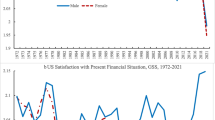Abstract
Women in nearly all countries of the world have lower incomes, are less educated, are more likely to be widowed or divorced, and report worse health than men. Based on the happiness literature, these inequalities should cause women to be less happy than men. This study investigates this hypothesis using the Gallup World Poll to estimate differences in happiness between men and women in 73 countries through country-specific ordinary least squares regressions. It then examines whether the magnitude of the female–male happiness gap can be explained by country characteristics, such as economic development, religion, or women’s rights. This paper provides evidence that women are either happier than men or that there is no significant difference between women and men in nearly all of the 73 countries examined; when comparing men and women with the same life circumstances, women are happier than men in nearly a quarter of the countries. The magnitude of the female–male happiness gap is not associated with economic development or women’s rights and there are no systematic patterns by geography or primary religion.




Similar content being viewed by others
Notes
Specifically, the regressions in this paper include employment status, existence of a health problem, type of occupation, and whether the responded attended a religious ceremony in the previous week as control variables. Graham and Chattopadhay include measures of sadness and enjoyment yesterday. Sadness and enjoyment variables are included as a robustness checks in this paper due to their potential endogeneity with overall life satisfaction.
The occupation variable is not available for Brazil and Hungary. Income data are not available for the Czech Republic, Denmark, Mali, Mozambique, and Panama.
References
Blanchflower, D., & Oswald, A. (2004). Well-being over time in Britain and the USA. Journal of Public Economics, 88(7–8), 1359–1386.
Central Intelligence Agency. (2010). Religions the World Fact Book. Retrieved from the Central Intelligence Agency website: https://www.cia.gov/library/publications/the-world-factbook/fields/2122.html.
Dolan, P., Peasgood, T., & White, M. (2008). Do we really know what makes us happy? A review of the economic literature on the factors associated with subjective well-being. Journal of Economic Psychology, 29(1), 94–122.
Easterlin, R. A. (2001). Life cycle welfare: Trends and differences. Journal of Happiness Studies, 2, 1–12.
Easterlin, R. A., & Angelescu, L. (2011). Modern economic growth and quality of life: Cross sectional and time series evidence. Forthcoming in K. C. Land (Ed.), Handbook of social indicators and quality-of-life research. Springer, New York.
Frey, B. S., & Stutzer, A. (2002). Happiness and economics. Princeton: Princeton University Press.
Gallup World Poll. (2009a). World Poll Survey Data. Washington, DC: Gallup Inc.
Gallup World Poll. (2009b). World Poll methodology. Washington, DC: Gallup Inc.
Graham, C., & Chattopadhyay, S. (2012) Gender and well-being around the world. Brooking institution. http://www.brookings.edu/research/papers/2012/08/gender-well-being-graham.
Graham, C., & Pettinato, S. (2001). Happiness, markets, and democracy: Latin America in comparative perspective. Journal of Happiness Studies, 2(3), 237–268.
Helliwell, J., Layard, R., & Sachs, J. (Eds.) (2012). World happiness report. New York, USA: The Earth Institute, Columbia University.
Knight, J., Song, L., & Gunatilaka, R. (2009). Subjective well-being and its determinants in rural China. China Economic Review, 20(4), 635–649.
Lalive, R., & Stutzer, A. (2010). Approval of equal rights and gender differences in well-being. Journal of Population Economics, 23(3), 933–962.
Nolen-Hoeksema, S., & Rusting, C. L. (1999). Gender differences in well-being. In D. Kahneman, E. Diener, & N. Schwarz (Eds.), Well-being: The foundations of hedonic psychology (pp. 330–350). New York: Russell Sage Foundation.
Plagnol, A. C., & Easterlin, R. (2008). Aspirations, attainments, and satisfaction: Life cycle differences between American women and men. Journal of Happiness Studies, 9(4), 601–619.
Powdthavee, N. (2010). The Happiness equation: The surprising economics of our most valuable asset. London: Icon Books.
Senik, C. (2004). When information dominates comparison. Learning from Russian subjective panel data. Journal of Public Economics, 88, 2099–2133.
Stevenson, B., & Wolfers, J. (2009). The paradox of declining female happiness. American Economic Journal: Economic Policy, 1(2), 190–225.
Stone, A., Schwartz, J., Broderick, J., & Deaton, A. (2010). A snapshot of the age distribution of psychological well-being in the United States. Proceedings of the National Academy of Sciences,. doi:10.1073/pnas.1003744107.
United Nations Educational, Scientific, and Cultural Organization (UNESCO). (2005–2008). Educational attainment of the population aged 25 years and older/latest year available. Retrieved from UNESCO website: http://stats.uis.unesco.org/unesco.
van Pragg, B. M. S. (2005). The connection between old and new approaches to financial satisfaction. In L. Bruni & P. L. Porta (Eds.), Economics and happiness: Framing the analysis (pp. 196–222). New York: Oxford University Press.
World Bank. (2010). World Development Indicators Online (WDI) database. Data retrieved from World Bank website: http://data.worldbank.org/data-catalog/world-developmentindicators.
Acknowledgments
I am grateful to the Gallup Organization for providing me access to the Gallup World Poll and to Richard A. Easterlin for his guidance on this paper.
Author information
Authors and Affiliations
Corresponding author
Appendices
Appendix 1
See Table 6.
Appendix 2
See Table 7
Appendix 3
See Table 8.
Appendix 4
See Table 9.
Appendix 5
See Table 10.
Appendix 6
See Table 11.
Appendix 7
See Table 12.
Appendix 8
See Table 13.
Rights and permissions
About this article
Cite this article
Zweig, J.S. Are Women Happier than Men? Evidence from the Gallup World Poll. J Happiness Stud 16, 515–541 (2015). https://doi.org/10.1007/s10902-014-9521-8
Published:
Issue Date:
DOI: https://doi.org/10.1007/s10902-014-9521-8




